Simple but tasty ways to pickle cabbage without brine and features of its storage
There are many ways making sauerkraut: magazines, online forums and cookbooks are full of recipes, and mothers, grandmothers or girlfriends will always give housewives a couple of new tips.
The organic acids, mineral compounds and carbohydrates it contains give the dish special value. The fermentation process makes the cabbage softer, making the vegetable easier to digest.
In this article we will share the most delicious recipes for pickling cabbage without brine.
Why salt cabbage without brine?
Cabbage cooked without brine is a classic and oldest recipe. The vegetable turns out more “vigorous” and remains crispy for a long time.
Advantages and disadvantages of this method
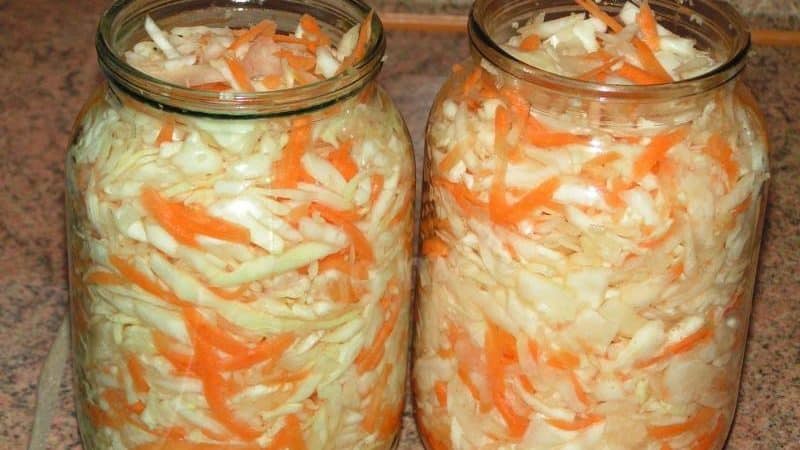
Let's take a closer look at the advantages of dry fermentation:
- the dish has a richer taste;
- the juice released during pickling has many beneficial properties, which are partially lost when brine is added;
- juice has a positive effect on the gastrointestinal tract, relieves constipation and dysbacteriosis;
- has a choleretic effect, prevents the development of urolithiasis;
- helps in the treatment of parasitic infections without having a negative effect on the liver;
- The juice stimulates the natural production of insulin and helps restore the body after a course of chemotherapy.
There are also disadvantages:
- Not every vegetable is suitable for dry fermentation - if the cabbage is not juicy enough, you won’t be able to ferment it, but this rarely happens with late varieties;
- Cabbage pickled in brine lasts longer than cabbage pickled in its own juice.
Selection and preparation
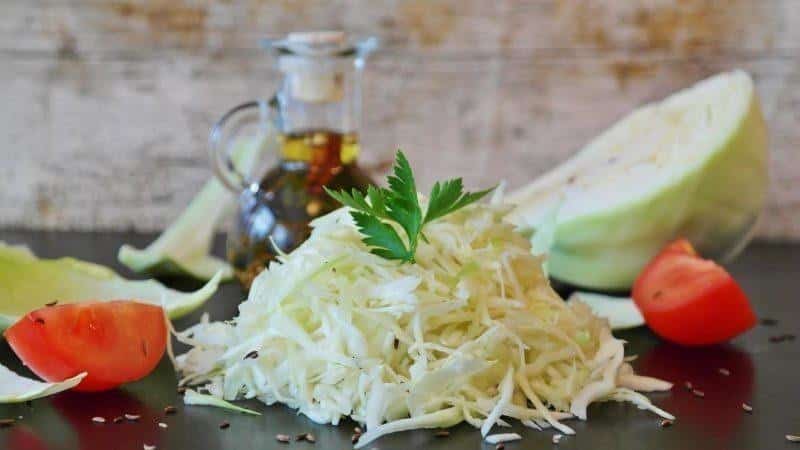
Half the success in preparing a dish is choosing good cabbage:
- Late varieties with a flattened shape are best suited for fermentation;
- choose a vegetable weighing more than 1 kg - small heads of cabbage have not had time to accumulate vitamins and absorb sweetness;
- when squeezed, a good vegetable will not lose its shape - if this happens, it means the head of cabbage was cut ahead of time and it will not be possible to ferment it without brine due to lack of juice;
- leaves of high-quality cabbage, when squeezed, release juice and crunch appetizingly;
- choose a head of cabbage that is light in color and without visible damage;
- tear off a cabbage leaf without traces of pests, otherwise the finished dish will spoil because of their waste products;
- It is better to cut the head of cabbage after the first frost - it contains more sugar and juice;
- if you buy a vegetable in a store or at the market, choose varieties and hybrids Slava 1305, Moskovskaya, Valentina, Aurora, Countess, Belorusskaya 455, Iyunskaya, Kazachok, Rinda, Tobia, Podarok, Menza F1, Aggressor, Amager 611, Moskovskaya late 15, Kharkov winter, Geneva F1, Turkiz, Atria F1, Miracle for pickling F1, Kvashenka, Polar MS, Megaton F1, Yubileiny F1;
- Before cooking, clean the cabbage from dirty leaves, do not wash the cabbage;
- A hand shredder is best for slicing - the straws will be thin and neat (12 mm each).
Tara
In Rus', wooden barrels were used for pickling cabbage; in such a container, the dish turns out to be the most delicious.
Attention! To prevent the bottom of a wooden barrel from rotting, a pallet is placed under it - the container will not come into contact with the wet floor of the cellar.
Nowadays, jars or large enamel jars are most often used. pans. If you do not plan to store cabbage all winter, use food-grade plastic or ceramic dishes, but glass is a better option. Metal and aluminum containers are not suitable for fermentation.
The main requirement for utensils for preparing pickles is that they be sterile.
How to salt cabbage without brine
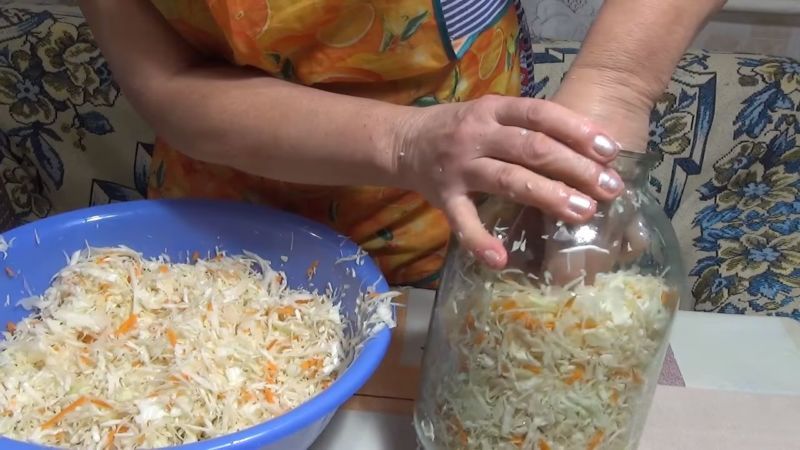
All recipes for dry pickling cabbage are based on the principle of grinding it with salt. As a result, juice is released in which the vegetable is fermented.
Ingredients and proportions
Required:
- cabbage - 2 kg;
- carrots - 2-3 pcs.;
- salt - 40-50 g (iodized salt cannot be used);
- sugar - 1 tsp.
Cooking instructions
Step-by-step instruction:
- Shred the cabbage.
- Add carrots chopped on a coarse grater.
- Sprinkle with salt and sugar, adding the latter ingredient if desired. The classic recipe does not use sugar.
- Mash all ingredients until juice releases. The most convenient way to do this is on a cutting board.
- Place the cabbage in a container, compacting it as much as possible. 2 kg of cabbage fits in a 3-liter jar.
- Place under a press whose weight is 10% of the total mass of the product, for example, in the form of a jar of water. Place the pressure in such a way that juice flows out from the edges.
- After two days, the fermentation process begins; it proceeds best at a temperature of +18-20°C.
- Twice a day, pierce the cabbage with the back of a wooden spatula to release the gas produced during fermentation. Otherwise, the dish will turn out bitter.
On days 10-12, the fermentation process ends and lactic acid is formed, which plays the role of a preservative and protects the vegetable from spoilage. During fermentation, foam forms on the surface. The readiness of the dish is indicated by clear juice and the cessation of gas emission. The product becomes crispy.
Serve this cabbage to the table, pouring oil and adding onions if desired.
Variations of the recipe for dry pickling cabbage
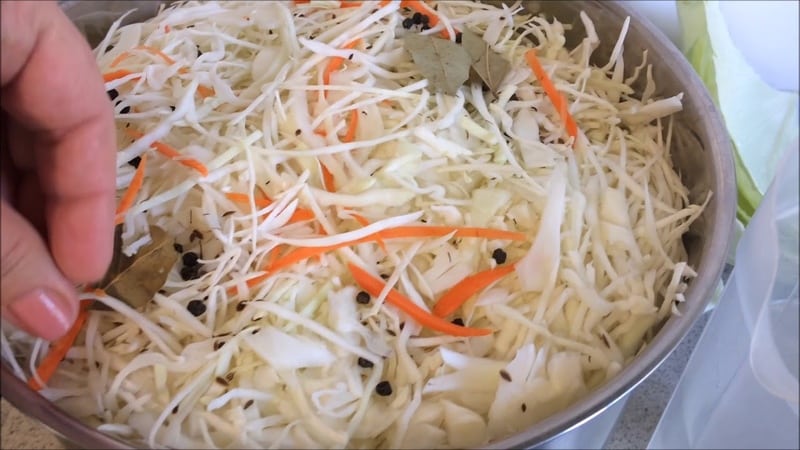
You can diversify the taste of a dish prepared according to a classic recipe by adding spices and other ingredients, changing the shape of the vegetable cut:
- add 8 black peppercorns and 4 bay leaves to the classic recipe, then the dish will acquire a more spicy taste;
- add cumin and dill seeds to taste - with such additives the dish is fermented for 10 days;
- keep the apples cut into quarters in salted water, ferment the cabbage with apples 12 days;
- Cover the bottom of a sterilized bucket with horseradish leaves, lay out layers of carrots and cabbage, sprinkling with lingonberries and cranberries, cover the container with gauze, and place under pressure for 10 days.
Features of storing such a workpiece
If you decide to store the product in the refrigerator, set the temperature below +5°C, otherwise the cabbage will remain fresh for no more than 3 days.
If you have prepared a large quantity of pickles, place the jars in a garage or basement with a temperature of 0 to +5°C. When the temperature rises to +10°C, the fermentation process resumes. Pickles are also stored on the balcony, but at temperatures below 0°C, the jars are covered with warm clothes and raised above the floor.
Other factors are also taken into account:
- indoor air humidity - 85-95%;
- The jars are placed in a place protected from direct sunlight.
How long a product will remain fresh depends directly on its storage location:
- in the refrigerator in a closed jar - 3 months, in an open jar - no more than 10 days;
- in the cellar - 3 months;
- at air temperatures above +10°C - no more than 3 days;
- on the balcony at an air temperature of +5 to 0°C - from 4 to 5 months;
- in the freezer - up to 8 months, defrosted product can be eaten within 5 days.
A prerequisite for long-term storage of pickles is carefully sterilized jars in a steam bath, in the oven, or treated with soda. The cause of mold on the product is bacteria, which die only with proper sterilization.
The juice released during fermentation covers the entire product. In addition to increasing shelf life, this will help preserve the vitamin C found in cabbage. For long-term storage, the jar is hermetically sealed with a plastic lid.
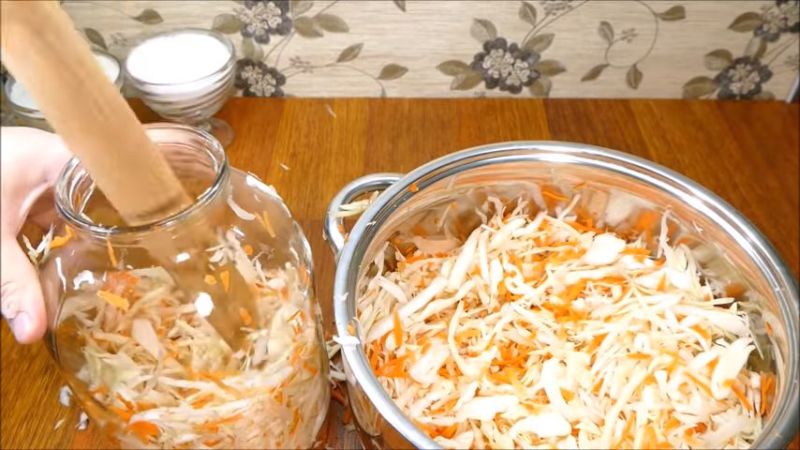
Useful tips that will extend the shelf life of the product:
- pour oil onto the surface of the workpiece - this is an excellent preservative;
- sugar will stop the fermentation process;
- if the cabbage is slightly acidified, it is used for preparing hot dishes, after washing it and adding a little sugar;
- Mustard will help prevent the proliferation of harmful microbes - pack it in gauze and place it in a bowl with cabbage;
- When cooking, add cranberries or horseradish.
Conclusion
Cabbage is useful in any form, including sauerkraut. The vitamins B and C contained in it are preserved for a long time even in an acidic environment. That is why it is especially useful to eat sauerkraut in winter, during a period of vitamin deficiency.
It is used to prepare vinaigrette, borscht, pies, or simply stewed.The shelf life of the product will increase due to high-quality sterilization, correctly selected containers and storage location, as well as compliance with the temperature regime.